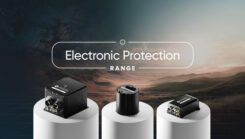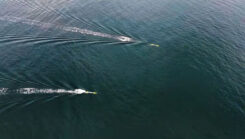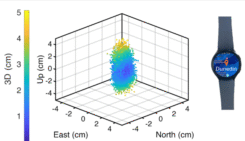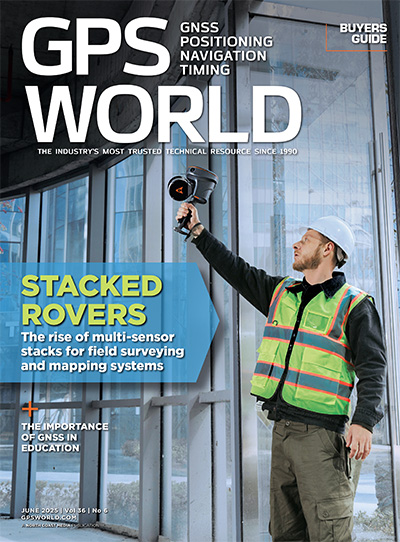With Racing Heart

 |
A new GPS/video system that tracks skiers’ position, their 100-kilometer-per-hour speed, and heart rate now gives the athletes, their coaches, and television viewers a novel performance analysis tool. The GPS data quantifies video motion analysis and enables evaluation of a skier’s performance and technique from startgate to finish. A heart-rate monitoring device further correlates the racer’s cardiovascular strain to the course profile and technical difficulties encountered.
GPS at the World Cup
In January 2001, television viewers enjoyed the latest in GPS application when a test run at Lauberhorn, Switzerland, displayed the precise position, speed and heart rate of former Swiss champion Xavier Gigandet over the strenuous Wengen World Cup downhill course.
This person-wearable device integrates GPS positioning, video alignment of sequences in time and space, and heart monitoring with internal data recording. The system makes it possible to precisely measure and compare athletic performances over an extended downhill racecourse.
 Waist harness containing GPS receiver and helmet with antenna |
New Training Tool. Coaches constantly ask how and why a racer can perform better at any given time. A position/velocity/acceleration (PVA) analysis gives the competitive edge of a point-by-point course performance examination and overall profiles between a racer’s own performances and those of other skiers.
Coaches and skiers devote long hours to slope recognition analysis, attempting to quantify many factors: the skier’s experience on a particular slope, current snow conditions, the skier’s ability, weight, and intuition, and others. A skier’s racecourse time only summarizes many decisions taken, and until now no means existed to separate good decisions from bad ones. GPS and video technology jointly offer the possibility of studying each turn separately. Their integration further enables analysis not only of personal performance, but also of equipment and waxing choices.
The Fastest Line. Finding the fastest line between race gates is a complex process, and the ideal trajectory is by no means always the shortest one. Choosing the shortest line may lead to excessive edging (in effect, braking), resulting in a slower exit speed from the turn. A wider turn may better preserve momentum and speed, yielding a faster overall time for the section.
 The Wengen downhill course |
Edging tactics may change completely when going from ice to softer snow conditions, or with a different slope angle. At 4.3 kilometers, Wengen is the world’s longest downhill course, and conditions over its length may vary substantially with altitude and corresponding temperature, so a racer’s tactics must adapt accordingly.
SimulCam Functionality. The "Simulcam" product, developed by Dartfish for use in training and television broadcasting, blends images from separate runs of the same athlete, or from two different athletes. This provides visual comparisons of their respective trajectories and movements.
In sports like downhill skiing, cameras usually record only a portion of the trajectory, enabling comparisons only over those parts of the course. GPS technique, on the other hand, functions independently from camera locations. Once we record the terrain model, we can create a virtual race to compare trajectories along the whole course. Of course, only image blending can present the full complexity of movements.
GPS tracking further offers an upgrade from qualitative information to quantitative data. Furnishing the precise value of the athlete’s speed and acceleration provides valuable information on the athlete’s and the equipment’s performance. Current setup in training or in equipment tests allows for time measurements to be made every 20 seconds. In a 150-second long race like Wengen only two or three intermediate time measurements are provided. Monitoring the skier with GPS boosts the comparison possibilities by a factor of 10 to 20.
 Figure 1 Speed versus the course terrain (Figures 1 and 2 depict tests run on a 2.2-kilometer segment of the 4.3- kilometer Wengen course) |
Overall, GPS-derived information complements the SimulCam functionality. Integrating them produces a tool for complete motion analysis.
Training Versus Broadcast. When developing the prototype of this system, we identified several possible applications. Its use by coaches or for television broadcast presents, however, substantial differences in technical requirements. Coaches require high accuracy, and robustness that may call for system augmentation. On the other hand, getting the results at the run end, or shortly thereafter, is sufficient. In contrast, TV producers constantly seek new features to enhance the show. They have less need for absolute accuracy, and speed estimation may not even need differential positioning, but they do require real-time display. This means sending the data from the skiers to a monitoring station as the skier descends the course – requiring substantial added infrastructure. The budget for covering an event like Wengen comes close to U.S. $1 million (including towers, helicopters, personnel, support equipment, and so on), so adding radio links may not be prohibitive. The receivers employed at Wengen had the functionality to broadcast this information.
Sub-Decimeter Accuracy
For useful analysis, a skier’s position must be determined with sub-decimeter accuracy, requiring differential carrier-phase GPS (CDGPS). The skier carries a rover receiver, and a base receiver is placed nearby. Both receivers must sample and store not only the pseudorange data, but also the carrier phase of the GPS signals at 5 Hz frequency or higher. Although ambiguous, the carrier-phase measurement possesses the desired centimeter-level accuracy. The GPS carrier-phase ambiguities are then determined post-mission by constantly evolving algorithms designed for high-dynamic applications. To determine the skiers’ velocity with highest possible accuracy, the GPS receiver also measures the carrier phase rate (that is, Doppler measurement).
 An earlier antenna version, that at high speeds could result in an airborne skier! |
System. Once advances in microelectronics had produced smaller, high-quality GPS receivers, we began investigating the potential application of this technology to alpine skiing here in Switzerland. The system used at Wengen in 2001 comprises a small, light (120 gram) high-performance antenna integrated into the ski helmet and a high-quality geodetic receiver (1 kilogram plus 0.4 kilogram battery) carried in a waistband.
The receiver can store raw pseudorange, carrier-phase and carrier-phase rate measurements at 10 Hz and on both GPS frequencies. The system carried by the skier is self-contained in the sense that no additional installation or modification needs to be done to the slope or its neighborhood except the placement of an identical receiver on a base station. Although the base station could be placed anywhere in the vicinity of the slope, the positioning accuracy will be better if the maximal distance between the skier and the base station is less than 5 kilometers. As the Wengen downhill is extremely long, we placed the base station at mid-slope (near Wengernalp) to assure centimeter-level positioning throughout the course.
Helmet Evolution. Choosing the antenna proved a difficult task, as we tried for the smallest possible size while keeping performance high. High-accuracy phase data requires a clear and strong signal to the receiver. As the receiver locks on satellites faster with a strong signal, we must also consider this factor when moving at high speed through signal blackout zones. Initial tests with other surveying antennas gave excellent results in this respect but using such large antennas in Wengen might result in lifting the skiers to the other side of Lauterbrunnen valley!
 Figure 2 (below) Profile of the racer’s heart rate during the race, including anticipation and recovery phases |
We also had to consider safety aspects. The skier must not "feel" or be affected or distracted by the antenna, its attachment cannot reduce safety, and in case of impact the antenna must not penetrate the helmet. We finally found a solution in a new lightweight antenna that works well with different kinds of receivers. Moreover, giving the helmet a special conductive coat boosted the signal to noise ratio (SNR) values to a level similar to that of a large surveying antenna.
Finding the right spot on the helmet for the antenna presented further difficulties, as the skier’s head position changes significantly during the race. Trial and error eventually produced an optimum placement, with minimal signal losses from the upright stance to the very low racer’s "tuck."
Receiver Evolution. Our laboratory at the Swiss Federal Institute of Technology (EPFL) focuses on human-based positioning and works on integrating GPS chips with other miniature navigation aids and with a PCMCIA (Personal Computer Memory Card International)-type of logging. The size of the overall system is sufficiently small and light not to be felt by a skier. Unfortunately, the first generations of the miniature GPS chips did not provide a sufficiently high sampling rate to cover the dynamics encountered in downhill racing. Recently we began collaboration with a GPS-oriented industry partner that should overcome such a drawback in the near future.
For these reasons we needed some other system, less adapted to human wearability, but possessing the required functionality. Finally we chose easily programmable receivers with functionality covering the spectrum of GPS applications from precise static measurement to high dynamic. These receivers can log all the necessary data internally at the desired 10 Hz sampling rate. We installed the receivers in a waist harness, placing their 1.4 kilograms close to the skier’s center of mass, so that they would not interfere with movements even at high speed. The cost of these high-end receivers could be considered excessive for a skiing application, but they served us well as the benchmark and proof of concept.
 Figure 3 Top: Race profile with indications on satellite visibility and signal reception. Middle: Racer’s trajectory when negotiating the S-turn above Hundschopf. Each dot represents GPS sampling of the skier’s position and velocity, although value of the latter is shown only when passing a gate. Bottom: Detailed analysis of the S-turn indicating the time and length of skier’s trajectory between gates 13 and 19. (In the top two charts, race history proceeds from right to left, while at bottom and on previous page it goes from left to right.) |
Obviously, it may take some time before helmets are manufactured with an antenna clip. The weight and size of the antenna is now at a comfortable level. Also, carrying a heart monitor on a chest belt next to the skin doesn’t constrain the skiers at all. By placing the receiver in a harness under the skiing suit instead of in a backpack, we made significant ergonomic progress.
Heart Rate
Adding a heart-rate monitor to the system provides information about the skiers’ cardiovascular strain during a race or training, and also through anticipatory and recovery periods.
This enables analysis of heart-rate patterns in conjunction with DGPS data of velocity and trajectory through the race. Factors such as topography (slope inclination, bumps), technical difficulties (critical turns, jumps), the racer’s training condition, duration of the race (fatigue), position (extended, "tuck") and attitude of the skier may all play a role. Performance variables such as the time required to reach the apparent individual maximum heart rate and heart-rate "recovery" after the race also represent important factors for each competitor.
As the heart rate is calculated over a period of a few seconds and changes no faster than every few seconds, the requirements for precise synchronization with respect to GPS time are not high. Practically, it suffices to note the GPS clock reading when switching on the heart monitor.
 On-screen broadcast product of the video/GPS/heart monitor integration tracking Swiss ski champion Xavier Gigandet |
A miniature, self-contained heart rate sensor on a light plastic belt around the thorax recorded the heart rate beat-by-beat and stored the data in a memory on the belt itself. Later we manually synchronized the data with GPS time. Figure 2 shows a typical profile of heart rate response during a race. In less than a minute a racer’s heart can reach a high beat rate, above 150 beats per minute. Note also the anticipation phase a few minutes before the start of the race, characterized by a net rise in heart rate, and explained by an increase in stress hormones.
Video Integration and Analysis
Synchronization accuracy for video footage, on the other hand, presents more challenges. An optimal way would be steering the video camera oscillator by the one pulse per second (PPS) rate, but that would be difficult practically as the TV system operates independently of ours. The drift of the TV clock is, however, negligible, at least over the period of several minutes, and therefore only an offset must be determined. We have chosen the shot of one gate where the camera angle had less of an influence on the projection of the skier when passing through (see photo, next page). This location, at the course’s upper portion, guaranteed good satellite visibility and high accuracy positioning (that is, with fixed ambiguities). Knowing this gate’s position meant also knowing the GPS time with respect to the clearly identified part of the video footage, so the synchronization process could take place.
Trajectory Analysis. At the end of the run (or several runs), we merge data from both receivers and perform post-processing to obtain 3-D position and velocities,10 times per second along the whole trajectory. These data give vital information about the skiers’ gate-to-gate performance over the whole course. They further allow comparison with competitors on any part of the slope and thus enable skiers to find an optimal glide path in difficult passages such as the S-turn before Hundschopf (Figure 3).
Video-Motion Analysis
Using virtual technology, Dartfish can produce 3-D video blending by combining different information to give an overall race picture. Their goal in Wengen – to produce a video of the skier with speed and heart rate information in graphic overlay – was achieved post-mission in three steps:
Data Preprocessing. As the GPS position and velocity is sampled at 10 Hz and the heart rate at 0.2 Hz, the latter is first up-sampled to the former’s rate and both data streams are then up-sampled to the 25 Hz video frequency. The video received from the broadcasting company is usually non-digital (that is, beta format) and therefore must be digitized for further processing.
Two Video Channels. Two video streams are created. First, a flash animation is produced displaying user-relevant information from GPS data (that is, skier’s instantaneous speed) as well as heart rate. This animation is then captured with recorder software and a video-readable (AVI) format is produced. The second stream is the actual digital video containing the skier’s run.
Video Blending. Once synchronized (visually, based on the skier’s departure or arrival) in GPS time, video-processing software carries out the actual blending and transforms the digital results back to beta format for broadcasting.
Operational Aspects
Satellite visibility at a World Cup downhill race is a serious concern. The courses are well-defined and their lines vary little from year to year.
At Wengen, we undertook thorough terrain recognition during the summer, and concluded that satellite visibility sufficed for more than 90 percent of the slope during a good constellation. Of course, at that time we could not simulate the behavior of a receiver when moving around potential signal obstructions at high speed. It turned out in winter that some of them caused fewer problems than expected. In particular, we happily discovered an improvement in signal reception in a section surrounded by mostly coniferous canopy, attributed to the winter (skiing) increase in speed with respect to summer. On the other hand, when a complete loss of lock occurs, the skier’s high speed presents a drawback, as the area over which no solution is provided increases substantially.
We knew there would be at least one complete signal blackout related to the famous tunnel that takes the racers under the railway. Although highly spectacular for the audience, this feature represents a nightmare for GPS positioning. After transiting the tunnel, it takes at least several "long" seconds for the phase-tracking loop to lock on the signal again. Reacquisition time may vary significantly with the type of receiver used. It takes only about three seconds for a skier to cover 100 meters in this area (see Figure 3), so fast signal reacquisition time is highly desired.
Perhaps surprisingly, the race start constitutes the other problematic zone for signal reception. Racers spend several minutes inside the starting house waiting for their turn. On its own this procedure could be tolerated, as the starting door usually sticks out of the building by a meter or two. This makes at least half of the sky visible for at least a 30 seconds immediately before the start, as the racer prepares to launch. However, our hopes diminished when a huge "balloon" displaying a sponsor’s advertisement was inflated just around and above the starting door. Rather than searching for a pocketknife, we stepped back and swallowed the fact that the first 100 meters would be lost for analysis – but the race can take place thanks to the sponsor’s generosity. Perhaps some day broadcast sponsors will lobby for World Cup courses to be optimized with respect to GPS signal reception . . .
Should we receive another invitation to Wengen, we may consider signal enhancement by means of pseudolites. The topography is ideal for this, with Jungfraujoch, the highest railway point in Europe (3,454 meters) serving also as a permanent GPS observatory, and overlooking a good part of the slope. The line of sight is also clear from the other side of the valley, the 2,970 meter Shilthorn featuring a 360-degree panoramic view restaurant. Both points are ideal operationally, with easy year-round access and a permanent power source.
Outlook
Combining detailed trajectory data with video footage creates a new tool for performance analysis, helping determine the fastest path and identify technical mistakes. This can lead to better training and preparation to boost performance. Integrating heart monitoring gives better knowledge of physical activity patterns and energy expenditure during races, and may lead to better understanding of the factors affecting performance.
We plan to explore other applications of this tool, adding comparative charts with trajectories, speed, and acceleration of the racers. We also intend to create a 3-D virtual world by combining the terrain model with the GPS data, producing a movie of the race from the skier’s viewpoint. A one-minute video sample, showing part of the Wengen downhill course, can be viewed at dgrwww.epfl.ch/TOPO/personnes/jsk/research/ski/Wengen01.htm (this address is case-sensitive). c
Manufacturers
The system described here used an SGM3900PA3 antenna from SiGEM (Ottawa, Ontario, Canada) and the SR530 receiver from Leica Geosystems (Heerbrugg, Switzerland). The heart-rate prototype was based on a sensor from Polar Electro Oy (Kempele, Finland). Dartfish uses Camtasia recorder software and Adobe Premiere video-processing software.
More information about the partners in this collaboration can be found at www.dartfish.com, dgrwww.epfl.ch/TOPO and www.unil.ch.
;

















Follow Us